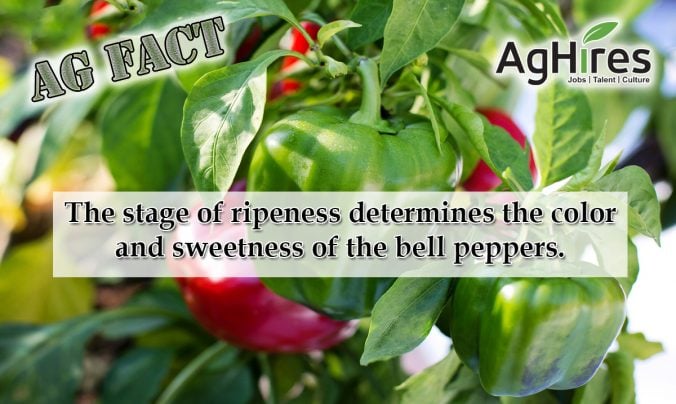
The bell pepper comes in a rainbow of colors and variety of shapes and sizes. The most common colors are green, red, orange, and yellow. The ripeness determines the flavor and color of each pepper. For example, red bell peppers are simply mature green bell peppers. The average consumption of the fresh bell pepper in 2017 was 11.4 pounds per person which was up 6% from 2015. Here are 15 more fun agriculture facts about the bell pepper:
- Bell Peppers are in good supply all year around; however, are less expensive and more abundant in the summer.
- The peppers come in a variety of shapes, colors, and sizes.
- The stage of ripeness determines the color and sweetness of the peppers.
- Typically, the green bell pepper stays fresh longer than yellow and red bell peppers.
- They range in size from 2 to 6 inches in length and 2 to 5 inches in diameter
- The peppers are not hot because they contain a recessive gene that eliminates capsaicin which is the compound responsible for the hotness found in other peppers.
- They are members of the nightshade family which also includes tomatoes, eggplant, and potatoes.
- The peppers originated in Central and South America and were carried throughout the world by Spanish and Portuguese explorers.
- Columbus found the peppers in the West Indies, but it wasn’t until the 16th century when they were introduced in Europe.
- The peppers do well at small-scale (those with less than 5 acres) and part-time farming operations.
- The peppers were first produced commercially in the southern United States, according to U.S. Department of Agriculture.
- Generally, farmers plant approximately 10,000 to 14,000 plants per acre on plastic-mulched beds in double rows 14 to 18 inches apart.
- During the growing season, most bell peppers are hand harvested two to four times.
- To improve shelf life of the mild and sweet bell pepper, the peppers are cooled after they are harvested.
- Florida ranks second nationally in bell pepper production which accounts for most of the United States grown peppers eaten by Americans.
Want more Agriculture Facts? Click here
Follow us on Facebook and Twitter to get your weekly dose of Ag Facts.
Written by: Amber DiCarlo, Marketing Intern
Sources:
Cals.arizona.edu
Wcjb.com
Delishably.com
These facts are the belle of the ball. Learn all about bell peppers now!






